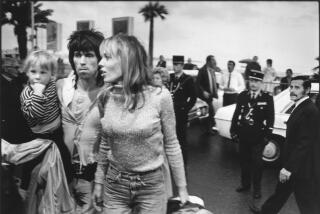It’s Over 30; Can Rolling Stone Be Trusted?
What’s going on with Rolling Stone magazine?
It’s a common question these days, and you can tell a lot about the person asking it by the degree of frustration in the voice.
Anyone who thinks the Sept. 19 issue of the rock magazine--the first under a new editorial mandate that will reportedly deliver shorter stories and flashier design features--is reason to start shedding tears must not have been paying attention to the magazine for a l-o-n-g time.
The challenge facing Rolling Stone isn’t its format, but its soul.
Editor-publisher Jann S. Wenner needs to figure out how to make the magazine essential again in a publishing world that has been inspired by it and has long been chipping away at its relevance.
Rolling Stone’s own editorial decisions in recent years have probably done more to harm the magazine’s credibility, however, than any threat from its direct rivals, which ranged from Spin and Vibe in the ‘90s to Blender and others now.
It’s not wise to judge a book by its cover, but you can tell a lot about a magazine from it, and Rolling Stone’s cover has reflected its slow, steady descent from a publication that brilliantly reflected the pulse of pop culture (especially music) to one whose chief purpose seems to be preserving its circulation figures.
All too frequently, the covers these days are more suited to Teen People (Britney Spears and all the boy bands) or Victoria’s Secret catalogs (lacy lingerie on starlets) than a magazine whose legacy is tied to John Lennon, Bob Dylan and Jimi Hendrix.
The Sept. 5 cover--the last one before the redesign--featured an actress whose chief credit in this country is her co-starring role in a two-bit summer action movie.
About Asia Argento, the cover language proclaims breathlessly: “She Puts the Sex in ‘XXX.’ ”
The story itself, most of which deals with Argento’s uninhibited language, barely fills two pages, though the editors found room for two more full pages of lingerie photos.
A far more noteworthy subject in the same issue--turntable master DJ Shadow, whose “The Private Press” is widely regarded as the best electronica album in ages--has to settle for far less space, and not even a mention on the cover. Some of the magazine’s compelling cultural coverage also tends to be slipped inside.
Sometimes the magazine has been lucky enough to camouflage its pin-up fascination by getting pop stars to adopt sexy poses.
The Dec. 6, 2001, cover featured Spears in a low-cut bra next to the words: “Britney Takes Charge. Her Life, Her Music and the Future.” The photo made an additional point: Her Breasts.
All too often, however, Rolling Stone has simply gone for starlets.
On the Feb. 14 cover, TV actress Jennifer Garner was showcased provocatively over the headline: “Just Your Average Butt-Kicking Coed in Leather.”
On May 23, the cover was Kirsten Dunst (in lingerie): “Dark Side of a Bright Star.”
On June 20: “Sex, Brains & Star Wars: The Very Private Side of Natalie Portman.”
This isn’t making too much of the cover subject. Wenner is so proud of the Rolling Stone cover legacy that in an introduction in 1998 to “Rolling Stone: The Complete Covers,” a coffee table book that reprinted every cover from 1967 to 1997, he wrote: “Our subjects have been the most creative people of these times, presidents and poets, the outsiders and insiders with their shoulders to the wheel and their pictures beneath the logo.”
And now we add: Asia Argento.
Wenner points out in his essay that the first cover--a publicity still of John Lennon from director Richard Lester’s movie “How I Won the War,” “speaks volumes about the marriage of music and movies and politics that came to define Rolling Stone.”
I’m not sure even Wenner imagined at the beginning that the movie component would consist chiefly of pin-ups. The first actress didn’t appear on Rolling Stone’s cover until 1972--109 issues after that first Lennon image. It was Jane Fonda, and she wasn’t wearing lingerie. She was on the cover because of her opposition to the Vietnam War.
This aura of compromise about cover subjects is a virus that has spread throughout much of the magazine.
Wenner was able to build Rolling Stone into a publishing empire because he saw far faster than other magazine moguls that rock ‘n’ roll was the language of choice for a generation around the world. He also had the insight and daring to move beyond music into noteworthy cultural issues.
The results were some cover stories that were thrilling in their timing. It took us to Woodstock and Altamont and into the bloody streets outside the 1968 Democratic convention in Chicago. It also led us inside the minds of some of the greatest artists of the time--often with long, penetrating Q&A; interviews by Wenner himself that remain definitive documents.
Rolling Stone showed respect for the music and attracted some of the finest young writers in the country, including Greil Marcus and Jon Landau on music and Hunter S. Thompson and Tom Wolfe on culture and politics. The magazine also featured the work of such gifted photographers as Annie Leibovitz.
It was an honor for writers to be published in the magazine and for musicians to be on the cover. The masthead still has some distinguished editors and writers, including Mikal Gilmore and Gerri Hirshey, but the question is where Wenner wants to lead them.
The magazine’s musical focus is blurred. It stopped years ago being the most reliable guide to new sounds. Rap’s 1980s trailblazers N.W.A and Public Enemy, for instance, never appeared on Rolling Stone’s cover, and Spin moved more aggressively in the ‘90s into alt-rock and metal.
Worse, Rolling Stone began accepting mere fame as a reason for coverage, rather than significance or talent. Like MTV, it treats the most disposable artists with the same respect it does great ones. Only sales matter. Hence, all the Britney covers.
Rolling Stone was pushed into this position because it now has hundreds of competitors, both magazines and newspapers. Many do excellent jobs, from the cockiness of the Village Voice to the sheer passion of Q and Mojo, two British monthlies whose design features are now being employed by Rolling Stone and Blender.
The theme of Rolling Stone’s Sept. 19 cover story--the return of passion in rock--was outlined months ago in the New Yorker, whose pop coverage is sporadic, but always smart and lively.
How can it fight back?
Above all, it needs to win our trust again by giving clear signs that it is committed to covering the most significant developments in pop culture rather than simply the most popular. If that costs it some circulation, so be it. A better Rolling Stone is preferable to simply a fatter one.
Wenner could begin by making bold, inspiring statements on the cover.
It’s easy to picture the editors sitting around a table back in the days when the magazine was starting out in San Francisco, debating which great artist to put on the cover.
Now transfer that meeting to 2002 in New York and imagine what went on when someone held up a photo of Asia Argento in her bra and unbuttoned jeans. Instead of ridiculing the idea of the shot on the cover, someone must have declared, “Great idea. That’ll sell!”
If that thinking persists, anyone who ever counted on Rolling Stone as a barometer for pop music may even stop asking the question about what’s going on at the magazine. They just may not care.
*
Robert Hilburn, The Times’ pop music critic, can be reached by e-mail at robert.hilburn@ latimes.com.
More to Read
The biggest entertainment stories
Get our big stories about Hollywood, film, television, music, arts, culture and more right in your inbox as soon as they publish.
You may occasionally receive promotional content from the Los Angeles Times.










